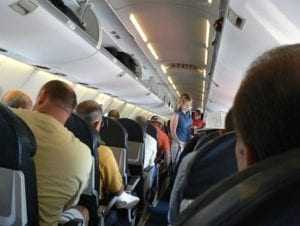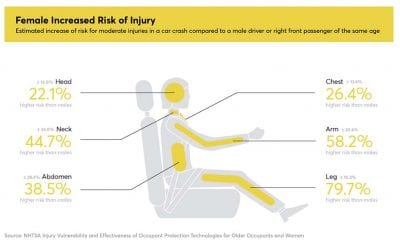Less airline seat pitch means more passengers on planes, slower emergency evacuations, and more medical inflight issues.

In the 2018 FAA Bill, Congress directed the FAA to do a study on less airline seat pitch. Did the new configurations of aircraft seating, packing more and more passengers into planes, affect plane evacuations? Can plane evacuations take place in 90 seconds with half of the doors blocked? And, does tight seating make fainting the most common infight medical emergency?
America now awaits the results of the study. As I understand it, the FAA completed a portion of the study. But the results after four years have not been released.
This week passenger advocates had a chance to speak to the new DOT Secretary for the first time and they brought up the issue of seat sizes and emergency evacuation. Of course, Secretary Buttigieg did not answer. No one knows because the testing with a plane filled with average passengers has not been completed. The only testing focuses on seat size.
Advocates have been told that the seat size testing is separate from the plane evacuation tests. So, where are the seat size tests? Advocates asked for observers of the tests and were told that we could not observe. Now, we want to hear the public findings.
This is an example of the need for continued consumer advocacy.

Travelers United’s president changed the complaint from comfort to health and safety at an advisory committee hearing
At hearings held before the Advisory Committee for Aviation Consumer Protection and before Congress, arguments were made based on health and safety. They are being compromised by having less seat pitch. The arguments about space are no longer focused on customer comfort or passenger service. Today, arguments focus on safety and health.
• Safety: Packing more seats into planes makes emergency evacuation more difficult and time-consuming, thus less safe.
• Health: Tighter seating means less movement for passengers, even while seated, thus increasing the incidence of deep-vein thrombosis.
Both issues have been studied by the FAA and DOT in the past. Both have been ignored by the FAA in its evacuation testing and airline certification processes.
Airlines did flirt with an idea of health during long-distance flights. Remember the leg exercises and bending over in your seat to stretch your back? Those stopped when seats were squeezed so closely together that an average person can no longer bend over in their airplane seat.
 FAA has refused to test safety and health on planes
FAA has refused to test safety and health on planes
When consumer groups asked the FAA to reconsider its rules on seat pitch (the distance from one seat to the same spot on the next seat), they have been rebuffed. The FAA says that the considerations they used for the rule were proprietary and that they have no passenger health mandate.
Not so, FlyersRights.com argued. They won in a case settled before the US District Court of Appeals for the District of Columbia (USCA Case #16-1101 Document #1643380 Filed: 10/28/2016). However, the FAA has still not changed its regulations. Today, airline consumers have a Congressional mandate to test evacuations and seating. But, the FAA is not doing its job.
As airline seats get tighter, seats themselves become thinner and less comfortable. Plus, the width of seats is getting narrower as Americans get, shall we say, broader. Let’s face it, coach passengers are facing a squeeze that they have never experienced before in the history of aviation.
Pets, on the other hand, are protected by specific space, food, and water requirements. With the differences between the front of the plane and the back of the plane getting more dramatic, some kind of human minimum space requirements should be mandated.
READ ALSO: “Preferred seats” — How airlines get more money from you
Prisoners sailing to Australia and Roman slaves had more legroom and seat pitch than today’s airline passengers.
In an article written about a decade ago, I noted that slaves and prisoners received more space than coach passengers today. Back in those days the UK was sending prisoners to Australia and the Romans were chaining slaves to their oars on their warships.
After a bit of research, I discovered that prisoners shipped from England to Australia 250 years ago were allotted a space of 18 inches per prisoner per seat.
Currently, according to sizewise.com, most coach airline seats are only 17-18 inches wide.
In other words, passengers today flying on an MD-80, 727, 737, 747-200, 747-200G, 747-400, 757, 767, MD-88, MD-90, CRJ-700, DC-9, DC-10, ERJ or Saab 340 SF3, are all flying with less seat space than a convict being transported to Australia more than two centuries ago.
According to historical records, galley slaves had a minimum of 36 inches of seat pitch as well as 18 inches of seat width.
Of course, no one would want to be chained to their wooden plank. But you get the idea. Even the ancient societies had minimum standards for human cargo and their workers. It helped the forced-labor work better and guaranteed that they could survive the trip. Today’s paying passengers should at least be able to expect the same.
Fainting from lack of oxygen and not sufficient movement are the top medical inflight emergencies
Finally, Travelers United published a story about “How to avoid passing out inflight at 35,000 feet.” While researching the story, the author learned that fainting spells are the most common inflight emergencies on planes. The cause of these inflight medical emergencies — tight seats with minimal legroom. Yet, even with what is common knowledge to flight crews and doctors, the FAA has mandated no minimums to mitigate these inflight medical emergencies.

Charlie Leocha is the President of Travelers United. He has been working in Washington, DC, for the past 14 years with Congress, the Department of Transportation, and industry stakeholders on travel issues. He was the first consumer representative to the Advisory Committee for Aviation Consumer Protections appointed by the Secretary of Transportation from 2012 through 2018.



